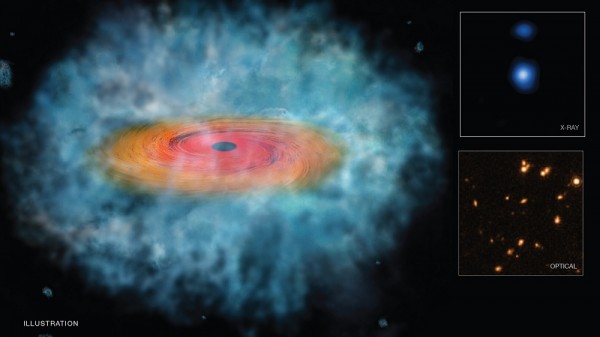Monster Supermassive Black Holes Come from Collapsing Cosmic Clouds
| Ana Verayo | | May 25, 2016 04:06 AM EDT |
(Photo : NASA/CXC/M. Weiss) This illustration depicts a possible "seed" for the formation of a supermassive black hole. The inset boxes at right contain Chandra (top) and Hubble (bottom) images of one of two candidate seeds, where the properties in the data matched those predicted by sophisticated models.
Most spiral galaxies in the universe such as our very own Milky Way galaxy host a supermassive black hole in its core, which is estimated to possess more than a million solar masses, or a million times bigger than our sun, however it still has been a mystery how these colossal cosmic entities emerged in the first place.
Like Us on Facebook
Some say that black holes first came into existence when it began sucking in clusters of gas from their surrounding areas in a galaxy. Another theory is that it attracted smaller black holes and eventually merged together.
For this new discovery, three of the world's largest space telescopes have gathered data and now suggest that there is a third driving force that generates black holes, involving collapsing gas clouds. According to Fabio Pacucci from the Scuola Normale Superiore in Italy, there is new evidence that supermassive black holes can directly sprout from a collapse of a gigantic gas cloud which can skip any more steps to emerge as a fully formed black hole.
According to Andrea Ferrara who is also from the Scuola Normale Superiore, there has been enough controversy how black holes take steps to form into a supermassive one, and this new study suggests that we are now closing in on the answer, as black holes begin to grow big at a normal rate as opposed to forming small and then growing at a rapid rate.
Now, new data are analyzed to form computer simulations courtesy of NASA's Hubble, Chandra X-ray and Spitzer space telescopes as astronomers detected two ideal candidates for these black hole "seeds" that are matched with predictions revealing a red color, seen by Hubble and Spitzer, including the X-ray profile from Chandra's prediction.
Apart from these, measurements obtained regarding distance also indicate that these black holes have formed when the universe was just under a billion years old, where all of this data was taken from the Cosmic Assembly Near-infrared Deep Extragalactic Legacy Survey and the Great Observatories Origins Deep Survey-South surveys.
NASA's next step would be to collect more data from these two possible candidates and extend this in depth analysis for more direct collapse black hole candidates. This new study will be published in the journal, Monthly Notices of the Royal Astronomical Society.
TagsBlack Holes, supermassive black holes, how black holes form, Universe, NASA, chandra, spitzer, hubble
©2015 Chinatopix All rights reserved. Do not reproduce without permission
EDITOR'S PICKS
-

Did the Trump administration just announce plans for a trade war with ‘hostile’ China and Russia?
-

US Senate passes Taiwan travel bill slammed by China
-

As Yan Sihong’s family grieves, here are other Chinese students who went missing abroad. Some have never been found
-

Beijing blasts Western critics who ‘smear China’ with the term sharp power
-

China Envoy Seeks to Defuse Tensions With U.S. as a Trade War Brews
-

Singapore's Deputy PM Provides Bitcoin Vote of Confidence Amid China's Blanket Bans
-

China warns investors over risks in overseas virtual currency trading
-

Chinese government most trustworthy: survey
-

Kashima Antlers On Course For Back-To-Back Titles
MOST POPULAR
LATEST NEWS
Zhou Yongkang: China's Former Security Chief Sentenced to Life in Prison

China's former Chief of the Ministry of Public Security, Zhou Yongkang, has been given a life sentence after he was found guilty of abusing his office, bribery and deliberately ... Full Article
TRENDING STORY

China Pork Prices Expected to Stabilize As The Supplies Recover

Elephone P9000 Smartphone is now on Sale on Amazon India

There's a Big Chance Cliffhangers Won't Still Be Resolved When Grey's Anatomy Season 13 Returns

Supreme Court Ruled on Samsung vs Apple Dispute for Patent Infringement

Microsoft Surface Pro 5 Rumors and Release Date: What is the Latest?










